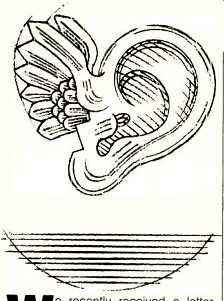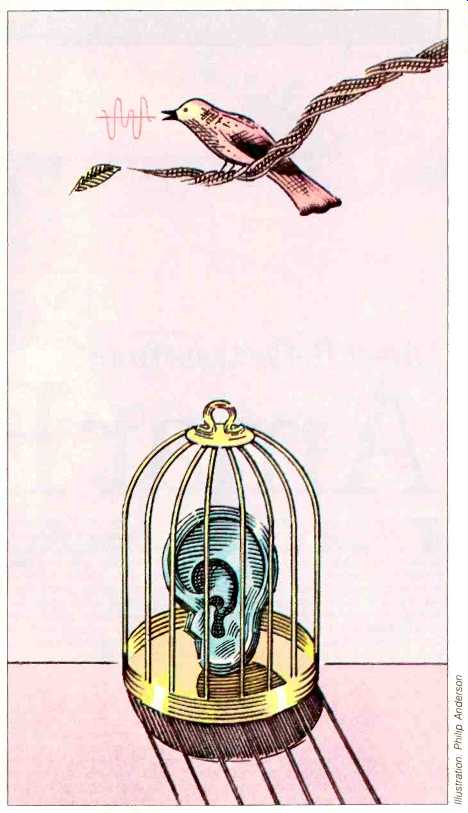
by JOSEPH GIOVANELLI
We recently received a letter vastly different from those which usually appear in my "Audioclinic" column. I believe, how ever, that the material will be of general interest and that those who have similar problems should know that they are not alone. We hope readers knowledgeable in this area will find the time to share their information by writing me at Audio. Where applicable, I'll forward useful items either to the writer, Jane H. Johnson of Laurel, Maryland, or to all of you via my column. Her letter and my reply follow:
A member of our family has a serious hearing loss in the upper register.
Her hearing is within normal limits (30% loss) up to 550 Hz. Above this frequency, her hearing declines precipitously so that by 600 Hz, she has lost 90% of her ability to hear.
Because her loss is within the conversational range of the human voice, she can hear vowels but no consonants. We find that she is unable to wear a hearing aid because no commercial aids can alter sound well enough to handle this acute loss.
We have noticed that whenever a man with an unusually low voice talks to her, she is able to understand him very well.

Is there any sound equipment on the market that will lower the pitch of a voice by one octave without otherwise distorting it? If such equipment is not available commercially, can it be built? If so, by whom? I have given a lot of thought to this problem, and I wonder if the right conclusion has been reached as to the reason this lady can understand some voices and not others. Certainly the frequencies she has lost are the very ones which convey information in the form of the consonant sounds. I simulated the conditions of her hearing by filtering out all the highs to see whether I could still get meaning in conversations by mainly hearing vowel sounds. I found that I could do so with great difficulty. I did not find that the pitch of the voice was a factor in my ability to understand what was said.
I am led to a different conclusion than was reached, but I definitely could be wrong. I wonder if those men, with their low-pitched voices, also have a particular vocal tract resonance which emphasizes some of the frequencies the lady has lost.
In any case, there may be a very simplistic way to check the correctness of the writer's conclusion. Using a 45-rpm recording of spoken words, play that disc and see how much is understood by the lady with the hearing loss. Now take that same recording and play it at 33 1/3 rpm. If the words are understood better, then the writer's conclusion seems correct. We are not just slowing the speech, but are also lowering the relative frequencies of the consonants. This might well put them within the range of her useful hearing.
If a recording of speech made at 45 rpm isn't available, one made at 33 1/3 rpm could be played on an old turntable capable of play at 16 2/3 rpm. If so, perform the same experiment. Under these latter conditions, we will have just what was asked about, a lowering of the pitch of the voice by one octave, though, of course, the tempo characteristics of the voice will be changed.
If appropriate recordings or turntables aren't available, a two- or three speed tape recorder can be used to perform this same experiment by re cording on tape at a high speed, and then playing it back at half speed.
Assuming all this shows promise, and despite the dragginess of the speech, there are digital sampling techniques which can be applied to the problem. These were really de signed to speed up or slow down the tempo of recorded speech without altering pitch, but they probably can be modified to lower the pitch of a voice while reasonably maintaining the speed at which speech is delivered.
There may be many firms engaged in this work, but the one I am certain of is The Variable Speech Corp., 185 Berry St., San Francisco, Cal. 94107. While speech processed in this way is not rendered in perfect high fidelity, it may well prove beneficial. I do not see any convenient way of having this system produce stereo sound, which might also be helpful.
For the moment, assume my conclusions are correct, and if so, attempt some more conventional solutions. As a 'test, I recommend the following experiment which requires a microphone be connected in a stereo system. Be cause most systems do not have a means for doing this directly, the mike may have to be connected to the input of a cassette deck and the output of the recorder to the rest of the system. If the lady has hearing in both ears, then two mikes should be used, as though a stereo recording were being made. It is likely that the recorder must be set to the "record" mode in order for the mikes to be heard at the headphones, which must be plugged into the stereo system, not the tape deck. The usual precautions about level apply even though no recording is being done.
It is well known that listening to conversation stereophonically (or binaurally) via headphones renders the conversation more intelligible than does monophonic reproduction. This is likely to be very important where the speaking persons are off-mike and all speaking at once. The stereo enhancement can be of even greater help where room acoustics are live and bright.
With the phones in place, a normal conversation should be carried on and the stereo system's tone controls adjusted in various ways to see whether a particular combination will produce an improvement in the lady's ability to understand conversation. An equalizer can be of great help because it can boost narrow portions of the audio spectrum, hopefully making use of the lady's residual hearing at the highest possible frequency.
I claim no expertise in this area. I have, however, known deaf people, and certainly recognize that their affliction isolates them from much of what goes on around them. I have listened to hearing aids and found their sonic qualities unpleasantly harsh and strident. Asked about this, the wearers indicated that they are also annoyed by the reproduction.
Perhaps what I have suggested will be helpful, but whether these approaches will be beneficial or not, I hope to hear from those with experience in this area.
[Editor Note: I asked my father, who has a similar but less severe hearing loss, and who was once in the hearing-aid business, for his advice. He states: "Even with a less severe high-frequency loss, lower voices are much easier to understand; the high, piping voices of small children are almost incomprehensible. If you cannot hear high frequencies, then 'p,"ph,"th,"s' and 't' all sound alike. If you mistake one for the other, you can lose the whole trend of a conversation.
"Hearing aids which emphasize high frequencies are on the market. How ever, I doubt if one would help with so severe a loss.
"A friend in the hearing-aid business reports that he has sometimes found that people with symmetrical hearing losses (the same in both ears) some times get asymmetrical benefits from hearing aids, gaining more low-frequency hearing when the aid is put in one ear, more high-frequency hearing when the same aid is put into the other.
In such cases, separate aids for each ear help.
"This solution is expensive, but it should be possible to try it at a hearing-aid dealer's and determine if it works in this case."-Ivan Berger]
(adapted from Audio magazine July 1983)
Also see: